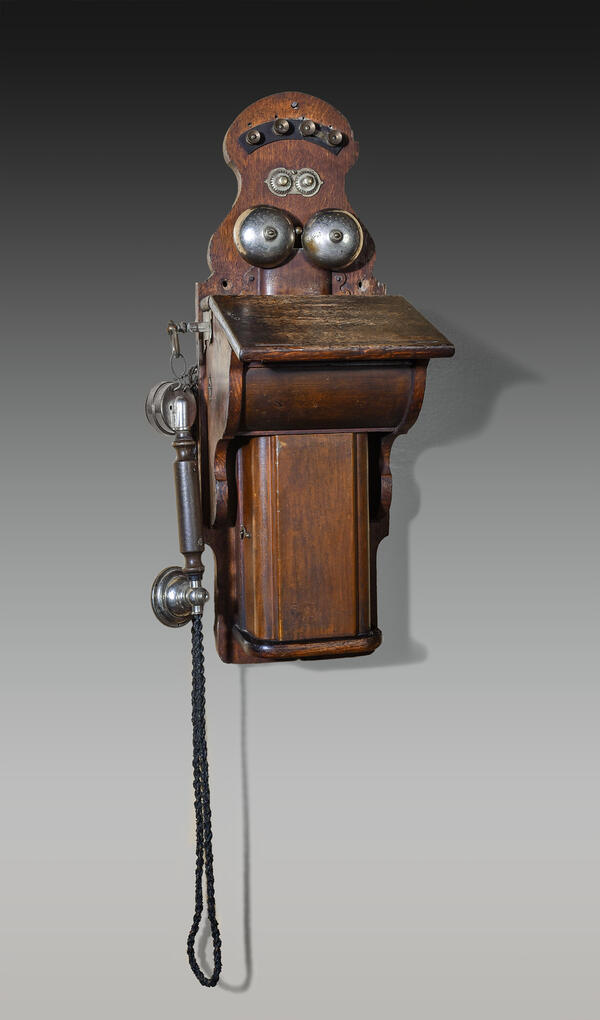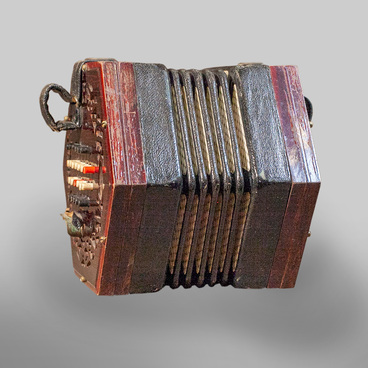The “Merchant’s Shop” section features a wall telephone made by the company “L.M. Ericsson & Co”.
The Swedish inventor Lars Magnus Ericsson began his career as a laborer. On April 1, 1876, together with his friend, Ericsson founded a mechanical workshop to repair telephone sets and signaling equipment. Soon, he designed his own device — a desk telephone with a magneto generator and a handset. The workshop was transformed into the company named “Ericsson & Co”.
Lars Ericsson worked 12 hours a day and upon returning home sometimes continued his work halfway through the night. An outstanding engineer, he designed most of the devices produced by his company. His telephone was referred to as “the Rolls-Royce of telephones”.
In 1897, Ericsson’s company established a telephone and electromechanical plant in St. Petersburg, Russia — the “L.M. Ericsson & Co” Joint Stock Company. Ericsson’s telephones were inexpensive, high quality, loud and clear, and competed successfully with the Bell Telephone Company. For his services to Sweden, the Ericsson family was granted a right to a lifetime free telephone connection throughout the country — apart from them, only the Swedish royal family had the same privilege.
One of the first Vyatka citizens to acquire an Ericsson telephone was Tikhon Philippovich Bulychev, one of the most famous citizens, a manufacturer and 1st-guild merchant, an outstanding entrepreneur, a steamship owner and a public figure, a philanthropist and a hereditary honorary citizen of Vyatka. He was known in the local community to have a penchant for tech innovations. He built Vyatka’s first and only mansion in the Romantic Art Nouveau style with Gothic elements and equipped it with state-of-the-art technology, including telephones on every floor of the building. To communicate with his office, which was located on the pier, Bulychev set up the first telephone line in the town and equipped it with Ericsson telephone sets.
The Swedish inventor Lars Magnus Ericsson began his career as a laborer. On April 1, 1876, together with his friend, Ericsson founded a mechanical workshop to repair telephone sets and signaling equipment. Soon, he designed his own device — a desk telephone with a magneto generator and a handset. The workshop was transformed into the company named “Ericsson & Co”.
Lars Ericsson worked 12 hours a day and upon returning home sometimes continued his work halfway through the night. An outstanding engineer, he designed most of the devices produced by his company. His telephone was referred to as “the Rolls-Royce of telephones”.
In 1897, Ericsson’s company established a telephone and electromechanical plant in St. Petersburg, Russia — the “L.M. Ericsson & Co” Joint Stock Company. Ericsson’s telephones were inexpensive, high quality, loud and clear, and competed successfully with the Bell Telephone Company. For his services to Sweden, the Ericsson family was granted a right to a lifetime free telephone connection throughout the country — apart from them, only the Swedish royal family had the same privilege.
One of the first Vyatka citizens to acquire an Ericsson telephone was Tikhon Philippovich Bulychev, one of the most famous citizens, a manufacturer and 1st-guild merchant, an outstanding entrepreneur, a steamship owner and a public figure, a philanthropist and a hereditary honorary citizen of Vyatka. He was known in the local community to have a penchant for tech innovations. He built Vyatka’s first and only mansion in the Romantic Art Nouveau style with Gothic elements and equipped it with state-of-the-art technology, including telephones on every floor of the building. To communicate with his office, which was located on the pier, Bulychev set up the first telephone line in the town and equipped it with Ericsson telephone sets.





